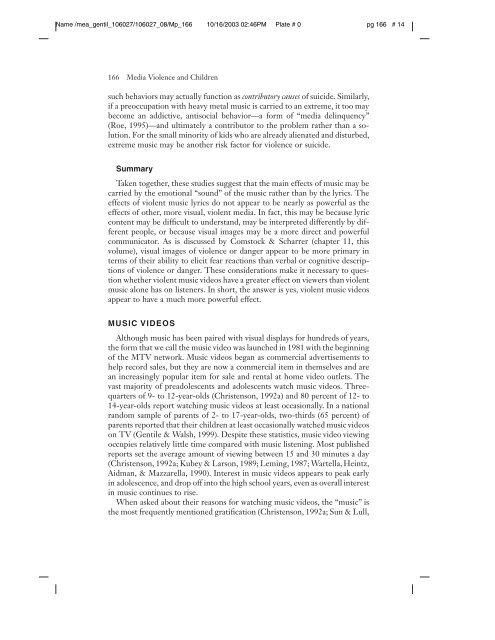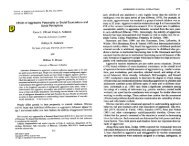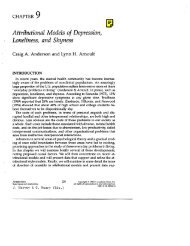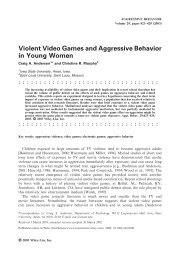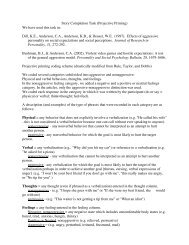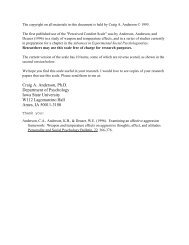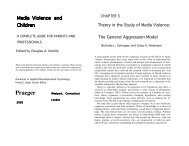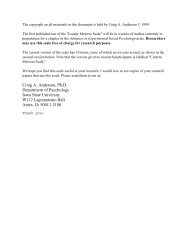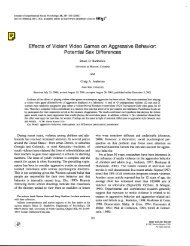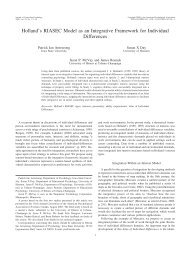The Effects of Violent Music on Children and Adolescents
The Effects of Violent Music on Children and Adolescents
The Effects of Violent Music on Children and Adolescents
You also want an ePaper? Increase the reach of your titles
YUMPU automatically turns print PDFs into web optimized ePapers that Google loves.
Name /mea_gentil_106027/106027_08/Mp_166 10/16/2003 02:46PM Plate # 0 pg 166 # 14<br />
166 Media Violence <strong>and</strong> <strong>Children</strong><br />
such behaviors may actually functi<strong>on</strong> as c<strong>on</strong>tributorycauses <str<strong>on</strong>g>of</str<strong>on</strong>g> suicide. Similarly,<br />
if a preoccupati<strong>on</strong> with heavy metal music is carried to an extreme, it too may<br />
become an addictive, antisocial behavior—a form <str<strong>on</strong>g>of</str<strong>on</strong>g> “media delinquency”<br />
(Roe, 1995)—<strong>and</strong> ultimately a c<strong>on</strong>tributor to the problem rather than a soluti<strong>on</strong>.<br />
For the small minority <str<strong>on</strong>g>of</str<strong>on</strong>g> kids who are already alienated <strong>and</strong> disturbed,<br />
extreme music may be another risk factor for violence or suicide.<br />
Summary<br />
Taken together, these studies suggest that the main effects <str<strong>on</strong>g>of</str<strong>on</strong>g> music may be<br />
carried by the emoti<strong>on</strong>al “sound” <str<strong>on</strong>g>of</str<strong>on</strong>g> the music rather than by the lyrics. <str<strong>on</strong>g>The</str<strong>on</strong>g><br />
effects <str<strong>on</strong>g>of</str<strong>on</strong>g> violent music lyrics do not appear to be nearly as powerful as the<br />
effects <str<strong>on</strong>g>of</str<strong>on</strong>g> other, more visual, violent media. In fact, this may be because lyric<br />
c<strong>on</strong>tent may be difficult to underst<strong>and</strong>, may be interpreted differently by different<br />
people, or because visual images may be a more direct <strong>and</strong> powerful<br />
communicator. As is discussed by Comstock & Scharrer (chapter 11, this<br />
volume), visual images <str<strong>on</strong>g>of</str<strong>on</strong>g> violence or danger appear to be more primary in<br />
terms <str<strong>on</strong>g>of</str<strong>on</strong>g> their ability to elicit fear reacti<strong>on</strong>s than verbal or cognitive descripti<strong>on</strong>s<br />
<str<strong>on</strong>g>of</str<strong>on</strong>g> violence or danger. <str<strong>on</strong>g>The</str<strong>on</strong>g>se c<strong>on</strong>siderati<strong>on</strong>s make it necessary to questi<strong>on</strong><br />
whether violent music videos have a greater effect <strong>on</strong> viewers than violent<br />
music al<strong>on</strong>e has <strong>on</strong> listeners. In short, the answer is yes, violent music videos<br />
appear to have a much more powerful effect.<br />
MUSIC VIDEOS<br />
Although music has been paired with visual displays for hundreds <str<strong>on</strong>g>of</str<strong>on</strong>g> years,<br />
the form that we call the music video was launched in 1981 with the beginning<br />
<str<strong>on</strong>g>of</str<strong>on</strong>g> the MTV network. <str<strong>on</strong>g>Music</str<strong>on</strong>g> videos began as commercial advertisements to<br />
help record sales, but they are now a commercial item in themselves <strong>and</strong> are<br />
an increasingly popular item for sale <strong>and</strong> rental at home video outlets. <str<strong>on</strong>g>The</str<strong>on</strong>g><br />
vast majority <str<strong>on</strong>g>of</str<strong>on</strong>g> preadolescents <strong>and</strong> adolescents watch music videos. Threequarters<br />
<str<strong>on</strong>g>of</str<strong>on</strong>g> 9- to 12-year-olds (Christens<strong>on</strong>, 1992a) <strong>and</strong> 80 percent <str<strong>on</strong>g>of</str<strong>on</strong>g> 12- to<br />
14-year-olds report watching music videos at least occasi<strong>on</strong>ally. In a nati<strong>on</strong>al<br />
r<strong>and</strong>om sample <str<strong>on</strong>g>of</str<strong>on</strong>g> parents <str<strong>on</strong>g>of</str<strong>on</strong>g> 2- to 17-year-olds, two-thirds (65 percent) <str<strong>on</strong>g>of</str<strong>on</strong>g><br />
parents reported that their children at least occasi<strong>on</strong>ally watched music videos<br />
<strong>on</strong> TV (Gentile & Walsh, 1999). Despite these statistics, music video viewing<br />
occupies relatively little time compared with music listening. Most published<br />
reports set the average amount <str<strong>on</strong>g>of</str<strong>on</strong>g> viewing between 15 <strong>and</strong> 30 minutes a day<br />
(Christens<strong>on</strong>, 1992a; Kubey & Lars<strong>on</strong>, 1989; Leming, 1987; Wartella, Heintz,<br />
Aidman, & Mazzarella, 1990). Interest in music videos appears to peak early<br />
in adolescence, <strong>and</strong> drop <str<strong>on</strong>g>of</str<strong>on</strong>g>f into the high school years, even as overall interest<br />
in music c<strong>on</strong>tinues to rise.<br />
When asked about their reas<strong>on</strong>s for watching music videos, the “music” is<br />
the most frequently menti<strong>on</strong>ed gratificati<strong>on</strong> (Christens<strong>on</strong>, 1992a; Sun & Lull,


